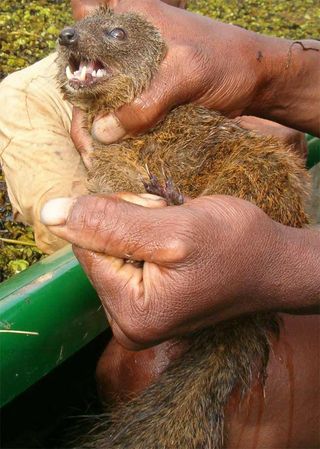
Newly Found Carnivore Already Threatened with Extinction

A speckled, cat-sized mammal has been identified in the nick of time, as its discoverers say the carnivore is one of the most threatened in the world.
Known as Durrell's vontsira, or Salanoia durrelli, the animal hides out in the Lac Alaotra wetlands in central eastern Madagascar. It weighs just over a pound (just over 0.5 kilograms) and belongs to a family of carnivores known only from Madagascar.
The animal was first seen swimming in a lake by researchers from the Durrell Wildlife Conservation Trust on a field trip surveying bamboo lemurs (Hapalemur griseus alaotrensis) in 2004. After briefly examining the it, the team suspected they had witnessed a new species and so took photographs.
Then, they compared what they had seen with specimens of the brown-tailed vontsira (Salanoia concolor) in the Natural History Museum's collections, confirming the animal was a new species. The brown-tailed vontsira is now the closest relative of the new species.
"We have known for some time that a carnivore lives in the Lac Alaotra marshes, but we've always assumed it was a brown-tailed vontsira that is also found in the eastern rainforests," said Fidimalala Bruno Ralainasolo, a conservation biologist working for Durrell Wildlife Conservation Trust who originally captured the creature. "However, differences in its skull, teeth, and paws have shown that this animal is clearly a different species with adaptations to life in an aquatic environment."
The habitat of Durrell's vontsira is threatened by agricultural expansion, burning and invasive plants and fish, the researchers say. And while there's no official word yet on the conservation status of the new species, it is likely to be threatened as a result of its small population size, restricted distribution (only found in Madagascar) and the impact of habitat degradation.
"This species is probably the carnivore with one of the smallest ranges in the world, and likely to be one of the most threatened," said study researcher Frank Hawkins of Conservation International.
Sign up for the Live Science daily newsletter now
Get the world’s most fascinating discoveries delivered straight to your inbox.
The findings are detailed in the latest issue of the taxonomic journal Systematics and Biodiversity.
Most Popular


